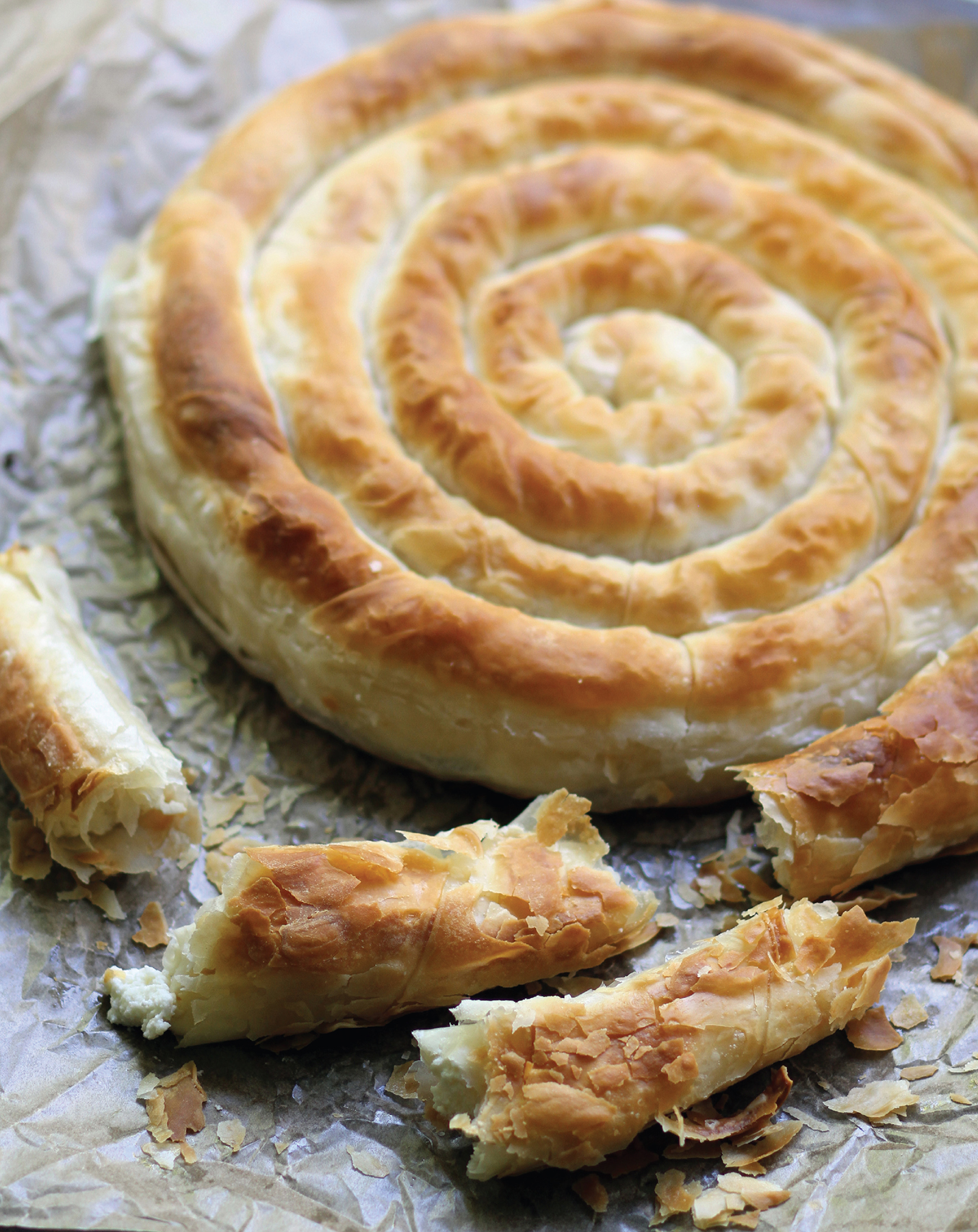

serves 8 to 10
Naoussa, a once buzzing commercial town in Macedonia in northern Greece, is now known more for its delicious, tannic red wines, made with the xinomavro grape, than for the textile manufacturing that was once its lifeblood. On a search to find how wine has insinuated itself into the local cuisine, I visited various pastry shops, finding everything from xinomavro chocolate truffles to sourdough bread made with red wine starter. One such bakery was Soula’s, who, in the true spirit of Greek hospitality, offered to take us to her home where she prepared a few local specialties. This pie, with its distinctly Macedonian phyllo pastry, bursting with butter and shaped into a coil, is her version of a traditional cheese pie from the area.
FOR THE PHYLLO
4 to 4½ cups (500 to 565 g) all-purpose flour, plus more for dusting
½ teaspoon salt
¼ cup (60 ml) extra-virgin Greek olive oil or vegetable oil, plus more for greasing
FOR THE FILLING
2 pounds (900 g) Greek feta, crumbled
4 large eggs
½ cup (1 stick / 115 g) butter, melted and clarified, plus more for brushing if desired
Olive oil, for brushing (optional)
Make the phyllo: In the bowl of a stand mixer fitted with the dough hook, combine the flour, salt, olive oil, and 1½ cups (360 ml) water. Mix on medium speed until the dough begins to come together in a mass. Knead for 8 to 10 minutes more, until the dough is smooth and doesn’t stick to the sides of the bowl.
Lightly oil a large bowl. Turn the dough out of the mixer bowl, form it into a ball, and place it in the oiled bowl. Cover with plastic wrap and let rest at room temperature for at least 30 minutes or up to 3 hours.
Make the filling: Combine the feta and eggs in a medium bowl.
Divide the dough into two equal-size balls. Let rest, covered, for a few minutes. On a floured surface, roll out the first dough ball to a large circle, about 20 inches (50 cm) in diameter. Place a dessert plate in the center of the circle. Using a sharp paring knife and working at equal distances around the plate, cut strips, like radii, extending from the rim of the plate to the periphery of the dough circle.
Remove the plate and brush the entire surface of the pastry with some of the melted butter. Next, fold in the first strip like a flap over the center of the pastry circle. Brush the exposed surface with butter. Repeat with each of the strips, folding each over the center like a flap and brushing the exposed surface. Once all the strips have been folded and buttered, pat around the periphery of the pastry to form a smooth-edged circle. Repeat with the second ball.
Cover each circle with plastic wrap and let rest for 20 minutes at room temperature or transfer to the refrigerator and chill for up to 24 hours. If refrigerated, bring the dough to room temperature before using.
Preheat the oven to 350ºF (175ºC). Brush a 15-inch (37.5 cm) round baking pan with butter or olive oil.
Roll out the first dough ball on floured surface to a circle about 18 inches (45 cm) in diameter. Cut the circle into strips that are 3 inches ( 7.5 cm) wide. Brush each strip with melted butter. Spread about 2 tablespoons of the feta filling down the length of each strip and fold over to cover the filling, pressing all the edges to seal. Take the cheese-filled cylinder and place one end in the center of the prepared baking pan. Gently twist the cylinder to shape it into a coil inside the pan. Repeat with remaining phyllo pastry and filly, twisting and placing the next cylinder at the edge of the first one, and continuing so the entire pan is filled concentrically with the gently twisted pastry. Brush the surface with butter and bake for 45 minutes to 1 hour, until puffed and golden. Remove from the oven, let cool, and serve.